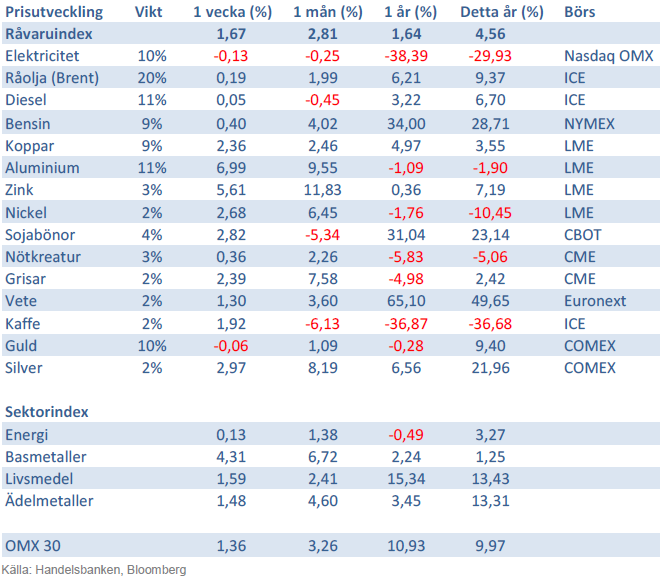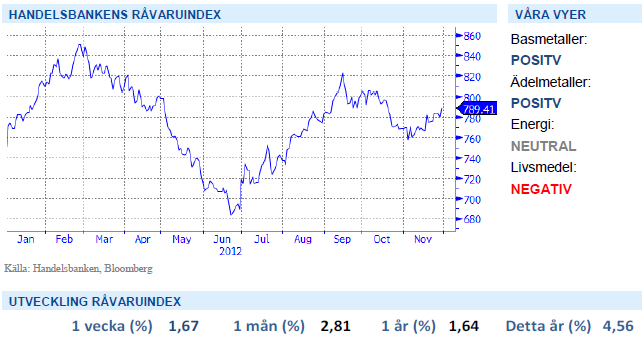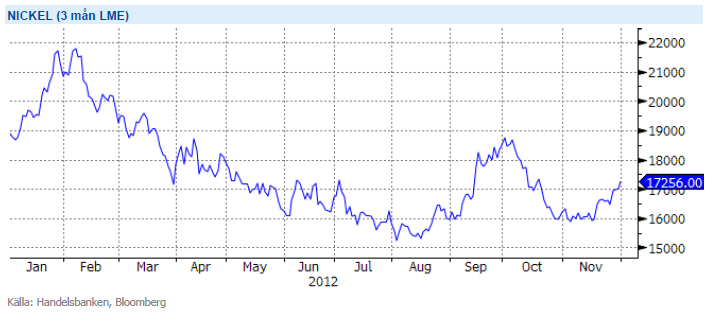Analys
SHB Råvarubrevet 30 november 2012
 Råvaror allmänt
Råvaror allmänt
Fiscal cliff fortsätter att spöka
Oron för fiscal cliff i USA tynger råvarumarknaden överlag och oljemarknaden i synnerhet (USA står för lite drygt en fjärdedel av den globala oljekonsumtionen). Detta är dock inget nytt, USA har ett budgetunderskott på 9 % av BNP och en statsskuld på närmare 110 % av BNP, så oron kommer att bestå under en lång tid. På kort sikt är det dock intressant att se om man kan nå en överrenskommelse, annars väntar åtstramningar på uppemot 600 miljarder dollar enligt de värsta pessimisterna (detta skulle motsvara 4 % av BNP vilket med största sannolikhet kastar USA tillbaka i recession vilket är allvarligt för den globala ekonomin).
Vi tror dock inte att det blir så illa (den politiska oförmågan att komma överens har tidigare skapat problem ex Standard & Poor´s nedgradering etc) så även om det innebär åtstramningar räknar vi att de blir mindre och att man kan hantera det. Inget nytt konkret och långsiktigt vad gäller Europas skuldkris gör att Kina återigen hamnar i fokus där penning och finanspolitik stödjer våra tillväxtförväntningar de kommande månaderna. Positiv dataskörd signalerar att den inhemska tillverkningsindustrin bottnar ut och indikativa PMI siffror kommer in på 13-månaders högsta nivå vilket ger stöd åt råvaror och metaller i synnerhet.
Basmetaller
Inga extrema prisrallyn i sikte
För basmetaller överlag så har produktionen kommit ikapp efter år av svag balans, detta var det allmänna intrycket från årets LME vecka under oktober vilket gör att vi inte förväntar oss några extrema prisrallyn på någon metall. Driftsättningen av nya gruvor är en stor utmaning för att möta en växande efterfrågan på lite längre sikt men på kort sikt ser balansen god ut. Utvecklingen i Kina gör dock att vi är positiva till basmetaller just nu. Flertalet har passat på att beta av lager (på stål och stålråvaror i synnerhet) som man nu försöker bygga upp igen vilket innebär orderingångar.
Ser vi till nickel skjuts flertalet investeringar på framtiden men vi räknar med en fortsatt produktionsökning om ca 5 % vilket gör att det inte finns utrymme för ett rally, speciellt inte när den globala rostfria sektorn är under fortsatt press. Vi räknar dock fortsatt med att nickelmarknaden är volatil, inte lika volatil som mellan 2007 och 2009 (när nickel föll från 50,000 dollar till under 10,000 dollar), där nivåer på 16,000 fungerar som stöd eftersom vi räknar med ett visst produktionsbortfall givet höga energi och lönekostnader. Våra prognoser ligger oförändrat på 17,500 USD för 2013 och 2014 för att sedan gå mot 18,000 USD vilket innebär en svag uppgång från dagens nivåer om 16,900 dollar.
Under oktober har basmetallerna haft ett kraftigt ras, efter den kraftiga uppgången i september. Finansmarknaden hade handlat in för mycket på för kort tid. Däremot ser Kinadata allt bättre ut nu. Vi tror på: BASMET H
Ädelmetaller
Volatila priser för de ädla metallerna
Ädelmetallerna har haft en stökig vecka där nyheter kring fiscal cliff har skickat priset både upp och ner. Guldet handlas i skrivande stund till 1730 USD/uns vilket är 1,3% lägre än förra fredagens stängning. Platinum och silver, som precis som guldet handlades ned kraftigt under onsdagen, stänger veckan i princip oförändrad. Palladium är veckans vinnare med en uppgång på 3,46%.
Guldet har ”stått och stampat” ett tag nu, även om det stigit med fem procent sedan senaste botten i början av november. Samtidigt är vi 150 dollar ifrån all-time-high på 1 900 per uns, noterat i september förra året. Vi anser att trots de höga nivåerna så är guldet köpvärt, åtminstone på kort sikt. Den viktigaste drivkraften är den stimulanspolitik som drivs just nu av världens centralbanker. Den gynnar guldet på två sätt, dels leder de exceptionellt låga räntorna till att man inte behöver avstå räntan för att äga guld. Men dessutom börjar alltfler nu undra om inte all denna stimulans till slut skapar inflation. Och just inflationsförväntan – inte inflationen själv – tror vi kan vara nog för att skicka guldet till nya rekordpriser ganska snart. Guldets stabilitet i orostider brukar vara det starkaste skälet till att äga guld, men inflationsskyddet kan visa sig vara en minst lika stark anledning att ha lite guld som komplement i sparportföljen.
Vi är fortsatt positiva till ädelmetaller med den främsta anledningen att vi tror på fortsatt mjuk penningpolitik från FED och att central bankernas stimulanser forstätter att ge stöd. Vi tror på: ADELMET H
Energi
Fortsatt riskpremie för oljan
Riskpremien på oljan har minskat något efter vapenstilleståndet i Gaza förra veckan men vi förväntar oss en fortsatt premie för den politiska oron som kan komma att påverka oljeleveranser från regionen. Något som också ger stöd är amerikansk lagerdata (senast 0,7 miljoner fat lägre än väntat). Även om råoljelagren är över normalen för perioden ser det betydligt värre ut på destillat och uppvärmningsolja i synnerhet, speciellt eftersom vi nu går mot en period av hög förbrukning i Nordöstra USA. Oljan handlas nu i nivå med bankens prognos på 110 dollar för 2013 (114 dollar för 2014).
Ny kapacitet har kommit till tack vare den höga prisnivån (speciellt skifferoljan från Bakken och Ford Eagle i Nordamerika har överraskat, dock är volymerna för små för att tala om att de enskilt kan lyfta fram USA till ett oljeoberoende år 2030) men mycket av kapaciteten är på betydligt högre kostnadsnivå vilket ger stöd åt nuvarande prisintervall (skifferoljan ligger på strax under 90 dollar och framöver bör man anta denna nivå eftersom borrning sker horisontellt med ökat fokus på miljövänlig process) runt 100 dollar om priset skulle börja falla tillbaka. Vidare behöver Saudi ett pris på närmare 100 dollar för att balansera sin budget vilket också minskar sannolikheten för något kraftigt fall under 100.
Oljan har sett allt svagare ut och vi fortsätter tycka att underliggande fundamenta är väl balanserad. Vi ser även att förutsättningarna för fortsatt lågt elpris kvarstår. Vi håller en neutral syn på energisektorn.
Livsmedel
Följ sojabönor – följ väderprognoser
För sojabönor kommer det sydamerikanska vädret kommer att hamna i fokus den närmsta tiden. Precis som för majsen är förhoppningarna höga och eventuella bakslag kan få stora effekter på prisnivån, efter dåliga skördar i främst USA förlitar sig marknaden på att Sydamerika ska leverera. Fokus är därmed på vädret fram till januari och februari (Argentina störst på majs och Brasilien på sojabönor om man ska följa vädret lokalt). Stöd till prisnivån ges även från stark kinesisk efterfrågan som fortsätter köpa stora mängder (köper ca 1/5 av globala som är 250 miljoner ton).
När Kina inte kan få sojabönor från USA riktas fokus mot Sydamerika. Inga stora variationer vad gäller kinesiska importsiffror där nivån är fortsatt hög. Förväntat utgående lager i förhållande till konsumtion är tajtare på sojabönor än på både majs och vete – får man då en dålig väderutveckling i Sydamerika bör sojabönorna öka mest i pris. Därför kan det vara intressant ur ett spread-perspektiv att förslagsvis sälja majs och köpa sojabönor. Kopplingen till energimarknaden på lite längre sikt är också intressant eftersom närmare 1/3 av världens socker, 10-15 % av vegetabiliska oljor och 10-15 av spannmålet förväntas användas till bränslen om 10 år!
Vi ser soja, majs och vete som klara säljcase där vi väntar oss prisfall senast till påsk. Vi tror på: LIVSMEDEL S H
Handelsbankens Råvaruindex

Handelsbankens råvaruindex består av de underliggande indexen för respektive råvara. Vikterna är bestämda till hälften från värdet av global produktion och till hälften från likviditeten i terminskontrakten.
[box]SHB Råvarubrevet är producerat av Handelsbanken och publiceras i samarbete och med tillstånd på Råvarumarknaden.se[/box]
Ansvarsbegränsning
Detta material är producerat av Svenska Handelsbanken AB (publ) i fortsättningen kallad Handelsbanken. De som arbetar med innehållet är inte analytiker och materialet är inte oberoende investeringsanalys. Innehållet är uteslutande avsett för kunder i Sverige. Syftet är att ge en allmän information till Handelsbankens kunder och utgör inte ett personligt investeringsråd eller en personlig rekommendation. Informationen ska inte ensamt utgöra underlag för investeringsbeslut. Kunder bör inhämta råd från sina rådgivare och basera sina investeringsbeslut utifrån egen erfarenhet.
Informationen i materialet kan ändras och också avvika från de åsikter som uttrycks i oberoende investeringsanalyser från Handelsbanken. Informationen grundar sig på allmänt tillgänglig information och är hämtad från källor som bedöms som tillförlitliga, men riktigheten kan inte garanteras och informationen kan vara ofullständig eller nedkortad. Ingen del av förslaget får reproduceras eller distribueras till någon annan person utan att Handelsbanken dessförinnan lämnat sitt skriftliga medgivande. Handelsbanken ansvarar inte för att materialet används på ett sätt som strider mot förbudet mot vidarebefordran eller offentliggörs i strid med bankens regler.
Analys
Tightening fundamentals – bullish inventories from DOE

The latest weekly report from the US DOE showed a substantial drawdown across key petroleum categories, adding more upside potential to the fundamental picture.

Commercial crude inventories (excl. SPR) fell by 5.8 million barrels, bringing total inventories down to 415.1 million barrels. Now sitting 11% below the five-year seasonal norm and placed in the lowest 2015-2022 range (see picture below).
Product inventories also tightened further last week. Gasoline inventories declined by 2.1 million barrels, with reductions seen in both finished gasoline and blending components. Current gasoline levels are about 3% below the five-year average for this time of year.
Among products, the most notable move came in diesel, where inventories dropped by almost 4.1 million barrels, deepening the deficit to around 20% below seasonal norms – continuing to underscore the persistent supply tightness in diesel markets.
The only area of inventory growth was in propane/propylene, which posted a significant 5.1-million-barrel build and now stands 9% above the five-year average.
Total commercial petroleum inventories (crude plus refined products) declined by 4.2 million barrels on the week, reinforcing the overall tightening of US crude and products.


Analys
Bombs to ”ceasefire” in hours – Brent below $70

A classic case of “buy the rumor, sell the news” played out in oil markets, as Brent crude has dropped sharply – down nearly USD 10 per barrel since yesterday evening – following Iran’s retaliatory strike on a U.S. air base in Qatar. The immediate reaction was: “That was it?” The strike followed a carefully calibrated, non-escalatory playbook, avoiding direct threats to energy infrastructure or disruption of shipping through the Strait of Hormuz – thus calming worst-case fears.

After Monday morning’s sharp spike to USD 81.4 per barrel, triggered by the U.S. bombing of Iranian nuclear facilities, oil prices drifted sideways in anticipation of a potential Iranian response. That response came with advance warning and caused limited physical damage. Early this morning, both the U.S. President and Iranian state media announced a ceasefire, effectively placing a lid on the immediate conflict risk – at least for now.
As a result, Brent crude has now fallen by a total of USD 12 from Monday’s peak, currently trading around USD 69 per barrel.
Looking beyond geopolitics, the market will now shift its focus to the upcoming OPEC+ meeting in early July. Saudi Arabia’s decision to increase output earlier this year – despite falling prices – has drawn renewed attention considering recent developments. Some suggest this was a response to U.S. pressure to offset potential Iranian supply losses.
However, consensus is that the move was driven more by internal OPEC+ dynamics. After years of curbing production to support prices, Riyadh had grown frustrated with quota-busting by several members (notably Kazakhstan). With Saudi Arabia cutting up to 2 million barrels per day – roughly 2% of global supply – returns were diminishing, and the risk of losing market share was rising. The production increase is widely seen as an effort to reassert leadership and restore discipline within the group.
That said, the FT recently stated that, the Saudis remain wary of past missteps. In 2018, Riyadh ramped up output at Trump’s request ahead of Iran sanctions, only to see prices collapse when the U.S. granted broad waivers – triggering oversupply. Officials have reportedly made it clear they don’t intend to repeat that mistake.
The recent visit by President Trump to Saudi Arabia, which included agreements on AI, defense, and nuclear cooperation, suggests a broader strategic alignment. This has fueled speculation about a quiet “pump-for-politics” deal behind recent production moves.
Looking ahead, oil prices have now retraced the entire rally sparked by the June 13 Israel–Iran escalation. This retreat provides more political and policy space for both the U.S. and Saudi Arabia. Specifically, it makes it easier for Riyadh to scale back its three recent production hikes of 411,000 barrels each, potentially returning to more moderate increases of 137,000 barrels for August and September.
In short: with no major loss of Iranian supply to the market, OPEC+ – led by Saudi Arabia – no longer needs to compensate for a disruption that hasn’t materialized, especially not to please the U.S. at the cost of its own market strategy. As the Saudis themselves have signaled, they are unlikely to repeat previous mistakes.
Conclusion: With Brent now in the high USD 60s, buying oil looks fundamentally justified. The geopolitical premium has deflated, but tensions between Israel and Iran remain unresolved – and the risk of missteps and renewed escalation still lingers. In fact, even this morning, reports have emerged of renewed missile fire despite the declared “truce.” The path forward may be calmer – but it is far from stable.
Analys
A muted price reaction. Market looks relaxed, but it is still on edge waiting for what Iran will do

Brent crossed the 80-line this morning but quickly fell back assigning limited probability for Iran choosing to close the Strait of Hormuz. Brent traded in a range of USD 70.56 – 79.04/b last week as the market fluctuated between ”Iran wants a deal” and ”US is about to attack Iran”. At the end of the week though, Donald Trump managed to convince markets (and probably also Iran) that he would make a decision within two weeks. I.e. no imminent attack. Previously when when he has talked about ”making a decision within two weeks” he has often ended up doing nothing in the end. The oil market relaxed as a result and the week ended at USD 77.01/b which is just USD 6/b above the year to date average of USD 71/b.

Brent jumped to USD 81.4/b this morning, the highest since mid-January, but then quickly fell back to a current price of USD 78.2/b which is only up 1.5% versus the close on Friday. As such the market is pricing a fairly low probability that Iran will actually close the Strait of Hormuz. Probably because it will hurt Iranian oil exports as well as the global oil market.
It was however all smoke and mirrors. Deception. The US attacked Iran on Saturday. The attack involved 125 warplanes, submarines and surface warships and 14 bunker buster bombs were dropped on Iranian nuclear sites including Fordow, Natanz and Isfahan. In response the Iranian Parliament voted in support of closing the Strait of Hormuz where some 17 mb of crude and products is transported to the global market every day plus significant volumes of LNG. This is however merely an advise to the Supreme leader Ayatollah Ali Khamenei and the Supreme National Security Council which sits with the final and actual decision.
No supply of oil is lost yet. It is about the risk of Iran closing the Strait of Hormuz or not. So far not a single drop of oil supply has been lost to the global market. The price at the moment is all about the assessed risk of loss of supply. Will Iran choose to choke of the Strait of Hormuz or not? That is the big question. It would be painful for US consumers, for Donald Trump’s voter base, for the global economy but also for Iran and its population which relies on oil exports and income from selling oil out of that Strait as well. As such it is not a no-brainer choice for Iran to close the Strait for oil exports. And looking at the il price this morning it is clear that the oil market doesn’t assign a very high probability of it happening. It is however probably well within the capability of Iran to close the Strait off with rockets, mines, air-drones and possibly sea-drones. Just look at how Ukraine has been able to control and damage the Russian Black Sea fleet.
What to do about the highly enriched uranium which has gone missing? While the US and Israel can celebrate their destruction of Iranian nuclear facilities they are also scratching their heads over what to do with the lost Iranian nuclear material. Iran had 408 kg of highly enriched uranium (IAEA). Almost weapons grade. Enough for some 10 nuclear warheads. It seems to have been transported out of Fordow before the attack this weekend.
The market is still on edge. USD 80-something/b seems sensible while we wait. The oil market reaction to this weekend’s events is very muted so far. The market is still on edge awaiting what Iran will do. Because Iran will do something. But what and when? An oil price of 80-something seems like a sensible level until something do happen.
-

 Nyheter3 veckor sedan
Nyheter3 veckor sedanStor uppsida i Lappland Guldprospekterings aktie enligt analys
-

 Nyheter4 veckor sedan
Nyheter4 veckor sedanBrookfield ska bygga ett AI-datacenter på hela 750 MW i Strängnäs
-

 Nyheter3 veckor sedan
Nyheter3 veckor sedanSilverpriset släpar efter guldets utveckling, har mer uppsida
-

 Nyheter3 veckor sedan
Nyheter3 veckor sedanUppgången i oljepriset planade ut under helgen
-

 Nyheter3 veckor sedan
Nyheter3 veckor sedanLåga elpriser i sommar – men mellersta Sverige får en ökning
-

 Analys3 veckor sedan
Analys3 veckor sedanVery relaxed at USD 75/b. Risk barometer will likely fluctuate to higher levels with Brent into the 80ies or higher coming 2-3 weeks
-

 Nyheter2 veckor sedan
Nyheter2 veckor sedanMahvie Minerals växlar spår – satsar fullt ut på guld
-

 Nyheter1 vecka sedan
Nyheter1 vecka sedanOljan, guldet och marknadens oroande tystnad














